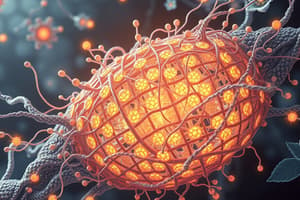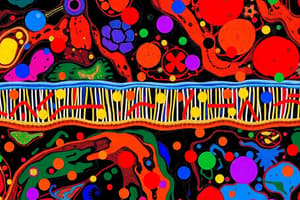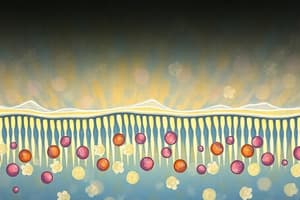Podcast
Questions and Answers
What is the role of an oxidoreductase enzyme?
What is the role of an oxidoreductase enzyme?
- To catalyze the transfer of a functional group from one molecule to another
- To catalyze the hydrolysis of a chemical bond
- To catalyze the breaking of various chemical bonds by means other than hydrolysis and oxidation
- To catalyze the transfer of electrons from one molecule to another (correct)
In an oxidoreductase reaction, what is the molecule that loses electrons called?
In an oxidoreductase reaction, what is the molecule that loses electrons called?
- Electron acceptor
- Hydrogen donor
- Reductant (correct)
- Oxidant
What type of enzyme catalyzes the transfer of a functional group from one molecule to another?
What type of enzyme catalyzes the transfer of a functional group from one molecule to another?
- Oxidoreductase
- Lyase
- Hydrolase
- Transferase (correct)
What is the role of a hydrolase enzyme?
What is the role of a hydrolase enzyme?
What is the key characteristic of lyase enzymes?
What is the key characteristic of lyase enzymes?
What type of reaction does a lyase enzyme catalyze?
What type of reaction does a lyase enzyme catalyze?
What is the name of the molecule that gains electrons in an oxidoreductase reaction?
What is the name of the molecule that gains electrons in an oxidoreductase reaction?
What type of enzyme catalyzes the reaction A–X + B → A + B–X?
What type of enzyme catalyzes the reaction A–X + B → A + B–X?
What triggers the opening of facilitated diffusion channels?
What triggers the opening of facilitated diffusion channels?
What is the direction of movement in facilitated diffusion?
What is the direction of movement in facilitated diffusion?
What is the role of kinase enzyme in facilitated diffusion of glucose?
What is the role of kinase enzyme in facilitated diffusion of glucose?
What is a characteristic of facilitated diffusion?
What is a characteristic of facilitated diffusion?
What is the net flux of facilitated diffusion?
What is the net flux of facilitated diffusion?
What is the function of transporter proteins in facilitated diffusion?
What is the function of transporter proteins in facilitated diffusion?
How many acetyl CoA molecules are produced from complete hydrolysis of palmitic acid?
How many acetyl CoA molecules are produced from complete hydrolysis of palmitic acid?
How many times are the 5 steps of β-oxidation carried out in the metabolism of palmitic acid?
How many times are the 5 steps of β-oxidation carried out in the metabolism of palmitic acid?
What is the total number of ATP molecules produced from the reduced coenzymes in the metabolism of palmitic acid?
What is the total number of ATP molecules produced from the reduced coenzymes in the metabolism of palmitic acid?
How many ATP molecules are produced from each NADH + H+ molecule in the electron transport system?
How many ATP molecules are produced from each NADH + H+ molecule in the electron transport system?
What is the net yield of ATP molecules from the complete oxidation of palmitic acid?
What is the net yield of ATP molecules from the complete oxidation of palmitic acid?
What is the energy requirement for the initial activation process of fatty acid metabolism?
What is the energy requirement for the initial activation process of fatty acid metabolism?
How many FADH2 molecules are produced from the β-oxidation sequence of palmitic acid?
How many FADH2 molecules are produced from the β-oxidation sequence of palmitic acid?
What is the number of ATP molecules produced from each FADH2 molecule in the electron transport system?
What is the number of ATP molecules produced from each FADH2 molecule in the electron transport system?
Who described the Lineweaver-Burk equation of enzyme kinetics?
Who described the Lineweaver-Burk equation of enzyme kinetics?
What is the purpose of the Lineweaver-Burk plot?
What is the purpose of the Lineweaver-Burk plot?
What is the y-intercept of the Lineweaver-Burk plot equivalent to?
What is the y-intercept of the Lineweaver-Burk plot equivalent to?
What is the x-intercept of the Lineweaver-Burk plot representative of?
What is the x-intercept of the Lineweaver-Burk plot representative of?
What is the main application of the Lineweaver-Burk plot in enzyme kinetics?
What is the main application of the Lineweaver-Burk plot in enzyme kinetics?
What type of inhibitors can be distinguished using the Lineweaver-Burk plot?
What type of inhibitors can be distinguished using the Lineweaver-Burk plot?
What are enzyme inhibitors?
What are enzyme inhibitors?
What is the equation of the Lineweaver-Burk transformation?
What is the equation of the Lineweaver-Burk transformation?
What is the product of the reaction involving glyceraldehyde-3-phosphate and NAD+?
What is the product of the reaction involving glyceraldehyde-3-phosphate and NAD+?
What is the source of the phosphate used in the reaction involving glyceraldehyde-3-phosphate and NAD+?
What is the source of the phosphate used in the reaction involving glyceraldehyde-3-phosphate and NAD+?
What is the product of the reaction involving 1,3-diphosphoglycerate and ADP?
What is the product of the reaction involving 1,3-diphosphoglycerate and ADP?
What is the result of the 8th step in glycolysis?
What is the result of the 8th step in glycolysis?
What is the product of the reaction involving 2-phosphoglycerate and H2O?
What is the product of the reaction involving 2-phosphoglycerate and H2O?
What is the result of the 10th step in glycolysis?
What is the result of the 10th step in glycolysis?
What is the alternative step chosen when anaerobic conditions exist within the cell?
What is the alternative step chosen when anaerobic conditions exist within the cell?
What is the source of the 2H atoms used to form lactate in anaerobic conditions?
What is the source of the 2H atoms used to form lactate in anaerobic conditions?
Flashcards are hidden until you start studying
Study Notes
Facilitated Diffusion
- Facilitated diffusion occurs down a concentration gradient only
- No net movement occurs if there is no concentration difference
- Rate of movement depends on the steepness of the concentration gradient and the number of transporter proteins (transport maximum)
- Glucose binds to a transport protein, which changes shape, moving glucose across the cell membrane down the concentration gradient
- Kinase enzyme reduces glucose concentration inside the cell by transforming glucose into glucose-6-phosphate
- Transporter proteins always bring glucose into the cell
Enzymes
- Oxidoreductase: an enzyme that catalyzes the transfer of electrons from one molecule to another
- Transferase: an enzyme that catalyzes the transfer of a functional group from one molecule to another
- Hydrolase: an enzyme that catalyzes the hydrolysis of a chemical bond
- Lyase: an enzyme that catalyzes the breaking of chemical bonds by means other than hydrolysis and oxidation, often forming a new double bond or ring structure
Lineweaver-Burk Transformation of the Michaelis-Menten Equation
- A graphical representation of the Lineweaver-Burk equation of enzyme kinetics
- Provides a useful graphical method for analysis of the Michaelis-Menten equation
- The plot gives a quick, visual impression of the different forms of enzyme inhibition
- Used to determine important terms in enzyme kinetics, such as Km and Vmax
- Helps distinguish competitive, noncompetitive, and uncompetitive inhibitors
Enzyme Inhibition
- Enzyme inhibitors are molecules that bind to enzymes and decrease their activity
Glycolysis
- A series of reactions that convert glucose into pyruvate
- The 7th step produces ATP molecules
- The 8th step involves phosphate moving from carbon-1 to carbon-2
- The 9th step removes a molecule of H2O from 2-phosphoglycerate
- The 10th step produces another ATP molecule
- The 11th step occurs under anaerobic conditions, adding 2H atoms to pyruvate to form lactate
Fatty Acid Oxidation
- ATP yield in fatty acid metabolism depends on the number of carbons in the fatty acid
- For example, palmitic acid (16C) yields 8 acetyl CoA molecules after complete hydrolysis
- Each operation of β-oxidation yields one FADH2 and one NADH + H+
- Reduced coenzymes channel hydrogen atoms into the electron transport system
- Total ATP yield from the oxidation of palmitic acid is 129 ATPs
Studying That Suits You
Use AI to generate personalized quizzes and flashcards to suit your learning preferences.




